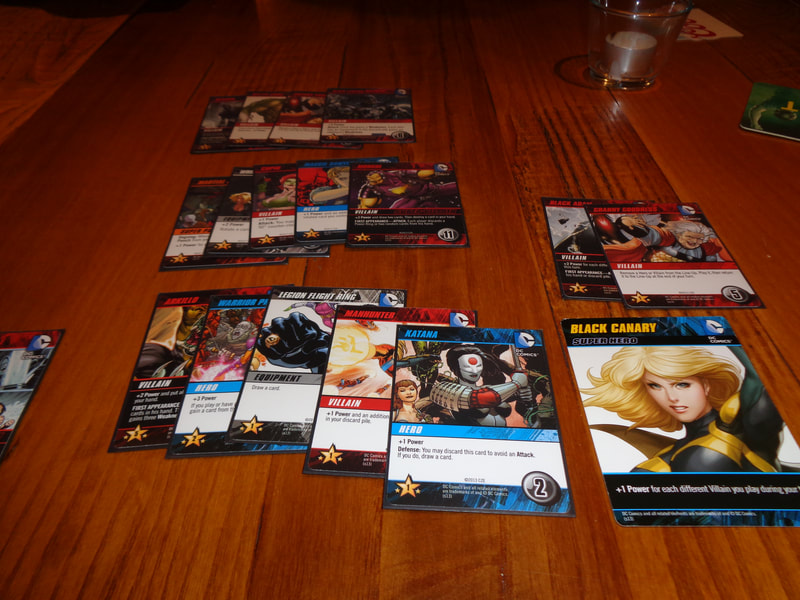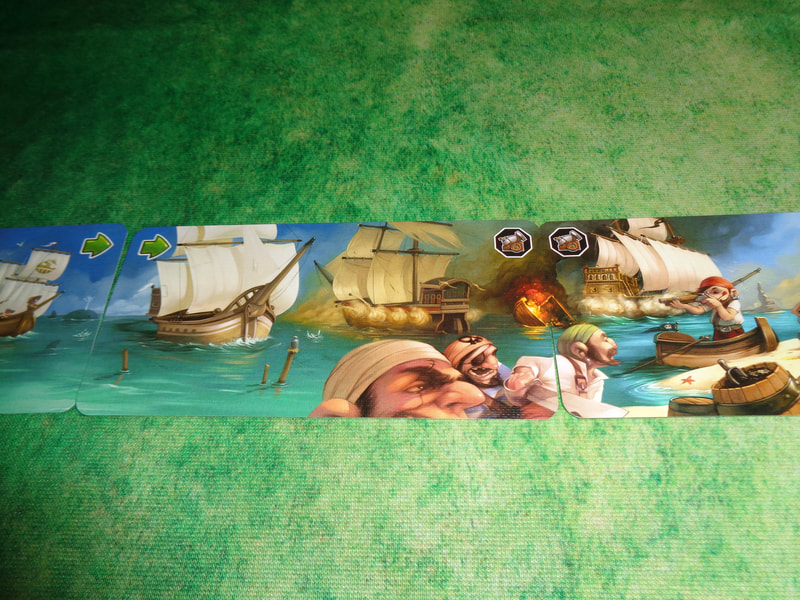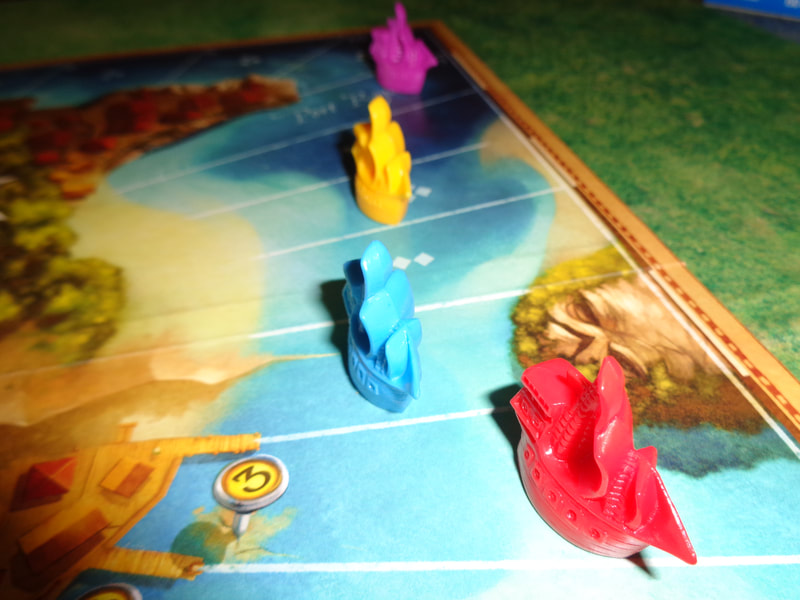|
26th September 2021
Sunday evening gaming on Board Game Arena has drawn to a conclusion. The final game of the night was Love Letter, read my blog about it here.
0 Comments
26th September 2021
Sushi Go! was the next game of Sunday gaming on Board Game Arena. Read my blog about it here. 26th September 2021
The next game of Gaming Sunday on Board Game Arena was Via Magica. Read my thoughts about it here. 26th September 2021
Sunday gaming on Board Game Arena continued with Dragonwood. Read my blog about it here. 26th September 2021 Sunday evening gaming on Board Game Arena continued with Cloud City. Travel around Cloud City and defeat Darth Vader and his stormtroopers... oh wait... what? This is an entirely different Cloud City! Be an architect and build up tower blocks in your model city to create walkways between them in this 3D tile laying game. Caveat: We've only ever played this game digitally. What's in a game?
The games iconography is similarly minimal but easily understood. I will add that since we've only played Cloud City digitally, it's hard to gauge how it would look with physical components, which could be quite good, judging from the photos I've seen. How's it play? Setup
On to play In Cloud City each player will create a 3x3 grid of tiles, buildings and walkways. Points are scored from walkways which are worth points according to their length, thus walkways score 1-8 points each.
Endgame Play continues until all players have completed their 3x3 grid, which always takes 8 rounds. Each player's victory points is equal to the value of the totalled numbers on all the walkway tokens they played. Points are tallied. Highest score wins Overall
In some ways, Cloud City is a standard tile-laying game: Put down tiles to create links and score points from them. However, because Cloud City adds a extra dimension (Sic.) to gameplay, the game has that sweet spot of simplicity of rules but depth of choice. Players can choose to try and create single long paths that score big on walkways or zigzagging small paths that score little but often. Players will also want to utilise all the empty space that their tiles inevitably generate. Managing to have walkways pass over or under others is an efficient way to rack up points. It lends Cloud City a almost puzzle-like quality. The rule limiting walkways to 2 per building is excellent, a good example of less is more, it prevents players from relatively easily creating a web of walkways and forces them to try and anticipate the direction they will need to take when putting down buildings, getting it wrong can cost points. Ideally, players will want to have a single snaking walkway that goes from building to building. That brings me to the game's other central mechanic; drafting. Cloud City employs 2 instances of drafting. Most obviously, is the tile drafting. Players can choose which tile from 3 to take to replace one they've played or draw blindly. This is a common implementation of drafting in tile placement games. It's the other type of drafting that's more interesting. Cloud City's rules mean that player's do not need to immediately connect buildings with walkways and this can present players with a conundrum: If a player does not immediately place walkways on their buildings, they can be taken later and placed in way to optimise scoring. There's a risk though, since there's a limited number of each walkway, particularly the 8 pointers, of which there are only 3 in each colour. Once they're gone, they're gone and to get one later can make a player lose out. Conversely, players can take and place walkways immediately, this is safer in one regard, but the risk here is that the tiles placed later may provide alternate better ways to score. This is something that players will always need to bear in mind. Cloud City mostly presents players with meaningful decisions to make and I found the urge to try and create the perfect network of walkways fairly compelling. It was a enjoyable experience that was easy to learn and played fairly quickly. 26th September 2021 Sunday evening is here and I'm logged into Board Game Arena for some gaming goodness. Similo: Fables is one of several different Similo games, as you may have surmised from the title, Similo: Fables is themed after folklore and fairy tales. Caveat: We've only ever played this game digitally. What's in a game? Similo Fables comes with a deck of 30 cards. Each card depicts a character from fairy tales, folklore and other fantastical stories, characters such as the 'Three Little Pigs', 'Cheshire Cat' and 'Cinderella'. The artwork on the cards is stylised and cartoony as well as bright and colourful. It suits the game's light tone well Similo: Fables uses no iconography to speak of. How's it play? Setup
On to play Similo: Fables is a co-operative game where the glue-giver and guessers must work together. The objective is for the guessers to guess which one of the 12 displayed characters is the secret character from clues given by the clue-giver and eliminate the other 11. How is this done? Read on:
Endgame During any of the games 5 rounds, if the players eliminate the secret character card, then the game is collectively lost by all players. If the game reaches the 5th round and they correctly eliminate the final false card, then by matter of elimination, the players will left with the secret character as the last card, in which case all the players collectively win. Overall
From the brevity of this blog, you can see that Similo: Fables is a game that manages to be both easy-to-learn and also co-operative, 2 game elements that quite often don't easily sit together. While the game is uncomplicated, it has some inherent depth that derives from it's interpretive/deductive mechanics which essentially means that with these sorts of game mechanics the players provide the depth. The clue-giver must agonise about how to give the best clue and try to anticipate how the guesses will receive it. In turn, the guessers must agonise about which cards to eliminate and try to gauge what the clue-giver was thinking. These are all meaningful decisions, which is always a good thing. Although it has to be said, that the more players know each other, the easier games like this become. I also like how the stakes increase every round, more and more cards will need to be eliminated and with a dwindling selection to chose from, it gets easier to make a game ending mistake. This keeps the tension high. Similo: Fables didn't quite deliver the gameplay we were looking for though; truth be told, it was perhaps a bit too light for us. Having said that, from observing the artwork, it seems that the game is targeted at younger players and for them, I think it's a good game, promoting creative thinking and especially with its co-operative nature, where everyone wins or everyone loses. I also think it's can be a good party game for non-gamers to play. 21st September 2021 The final game of Tuesday gaming with the Woking Gaming Club in The Sovereigns in Woking was DC Deck Building Game: Heroes Unite, which is both quite a mouthful and not pirate themed game, unless of course there's a Pyscho-Pirate card in there somewhere or something? So apparently there are several differently themed DC Deck Building Games out there and Heroes Unite is one of them, it is both an expansion to the core game and a standalone game. All these deck-builders make use of a game-engine called the Cerberus System. What's in a game?
The cards are standard quality playing cards as you'd expect. It's also no surprise that they're all decorated with fairly high quality colourful comic book styled artwork, although I'm uncertain if it's been sourced from actual comic books. There's little iconography, most of the game's information is provided via text on cards which is mostly quite clear. How's it play? Setup
On to play
Endgame Play continues until 1 of the following conditions is met. There are no more supervillain cards to flip over, i.e., there are no more supervillain cards. Or. There are not enough cards to fill the line-up with 5 cards, i.e., the deck has run out. When one of these conditions have been, all players put all their cards into their discard stack. Players then total the victory points they get from cards and deduct 1 point for each weakness card they have. Points are tallied, highest score wins. Overall
Hmm, what to say about DC Deck Building Game: Heroes Unite. Players will look to use their cards to generate currency that allows them to buy more cards that generate even more currency, eventually acquiring the most powerful cards confer extra abilities and grant victory points. It's pretty standard deck-building fare which contains mechanics and elements that will be familiar ground if you've played other deck-builders, which is to say the core mechanic is pretty solid, enjoyable fun and generally always provides players with meaningful choices to ponder. However, the game adds a few new elements to the traditional formula. The addition of a line-up mechanic is a definite positive, it forces players to adapt to whatever cards become available instead of falling back on tried and tested strategies. Even so. it's still quite easy to quickly create combos and it can be very satisfying to do so; but perhaps it's too easy I was told Ant, the game's owner that sometimes a player gets to build up momentum much quicker than other players and they end up creating more and more combos, allowing them to (In Ant's words.) 'steamroller' their opponents. Heroes Unite also provides a slightly greater focus on targeting players and attacking, both by players and supervillains! It lends the game a slightly different, more antagonistic feel and offers a extra avenue to strategy to pursue. It's hard to fault Heroes Unite but at the same time and apart from the theme, it doesn't really stand out from the crowd. If you don't own a deck building game and fancy getting one, you could worse then getting Heroes Unite, it's a good a place to start as anywhere. If you want a superhero themed deck builder, then this is worth a look. If you want a DC Comics superhero themed deck builder, then it's definitely worth a harder look. If you want a DC Comics superhero themed deck builder where you play as side-kicks and 'B-listers', then this really is the game for you! 21st September 2021
Tuesday night game at The Sovereigns in Woking with the Woking Gaming Club. Continuing the Speak like a Pirate day theme, the next game of the evening was Port Royal. Read my blog about it here. 21st September 2021 It's a Tuesday and I'm at The Sovereigns in Woking with the Woking Gaming Club. In honour of Talk Like A Pirate Day, the first game of the evening was Jamaica, a game of pirate racing. However, before we move on: "My wife's gone to the West Indies." "Jamaica?" "No, she went of her own accord!" With that out of the way, let's continue. What's in a game?
The overall art direction for Jamaica is colourful and makes use of a cartoonish style that suits the game's comical theme. The gameboard is brash with brightly coloured art but the standout are the player decks; not only do they share the board's style, they can be placed side-by-side to create a single long picture. The game doesn't use much iconography, what there is of it is easy to understand. How's it play? Setup
On to play In Jamaica, the Captain rolls the dice and assigns them to the game's 2 different phases per turn. Each player then chooses 1 of their 3 available cards to play and then performs the day and night actions on those cards. how effective those actions will be are determined by dice rolled and allocated to day and night.
Endgame Play continues until a ship reaches the start/finish, upon which the current turn is completed and the game goes to scoring. There are 4 sources of scoring. Players score points according to where their ship finished, the start/finish scores 15 and points go downwards from there. If a ship failed to pass the -5 space, then they lose 5 points. Every gold token a player has on their player board scores a points. Treasure cards score their points and cursed treasure cards deducts from the player's score. Points are tallied, highest score wins. Overall
In Jamaica, players must balance the need to load resources with the need to move along the game track, doing too much of one or the other will probably be detrimental. They'll need to judge when it's the right time to move with the right amount of resources. The rules limiting how players fill their holds forces players to make decisions about what they carry on their ships. Players will also need to mitigate bad rolls and unfavourable cards, e.g., playing a red arrow backwards move when the die shows a 1. At the same time it's also a good idea to keep an eye out for other players. If another player is 3 spaces away and one of the dice rolled a 3, there's always the risk that opponent will end moving on to your space, provoking a fight, which could prove costly. Perhaps it might be a good time to load some gunpowder... Obviously, all of this is to some extent is influenced by the dice rolls, having all the gold in the world wont help if a player can't reach a port! It means players will need to adapt to this randomiser and change strategies when the dice - and sometimes the captain don't give player the results they need. Jamaica is a cheerfully colourful game with fairly light programming game where players 'only' have to think 2 moves ahead, with a theme that fits well with the mechanics. Jamaica also has elements of resource management and a touch of player interaction and conflict. It's an easy to learn programming game that is fun to play, particularly if you like a little bit of jostling between players and generally presents them with meaningful choices to make. 19th September 2021
The last game of Sunday evening gaming on Board Game Arena was Love Letter. Read my blog about it here. |
AuthorI play, I paint. Archives
March 2024
Categories
All
|

























 RSS Feed
RSS Feed
